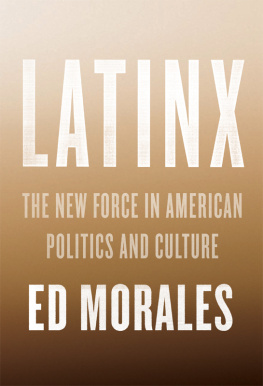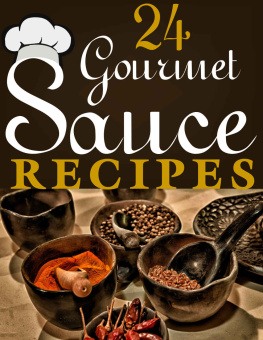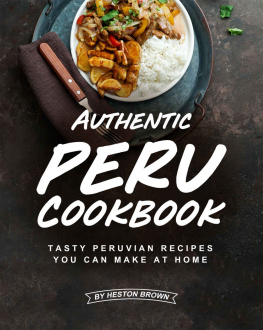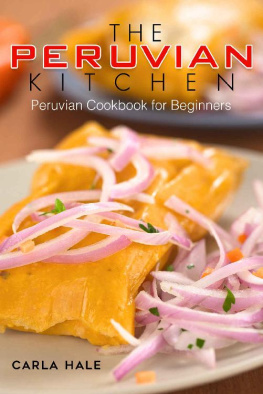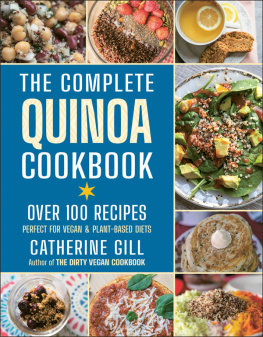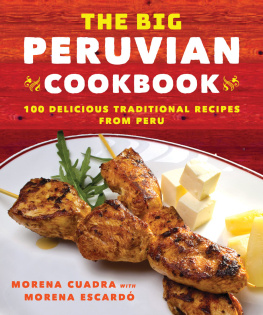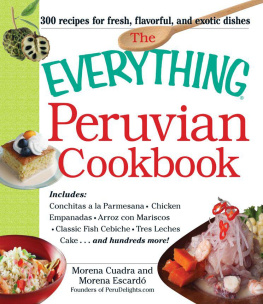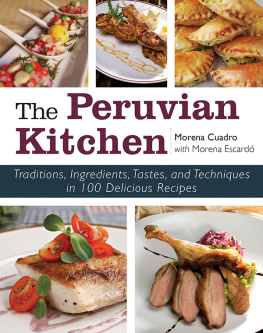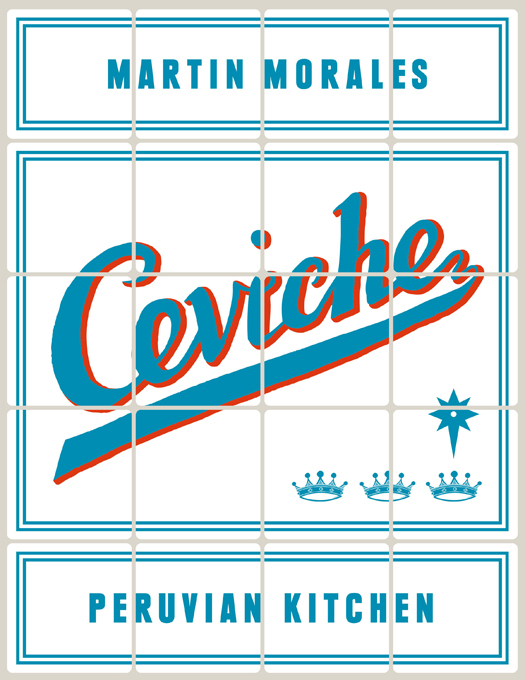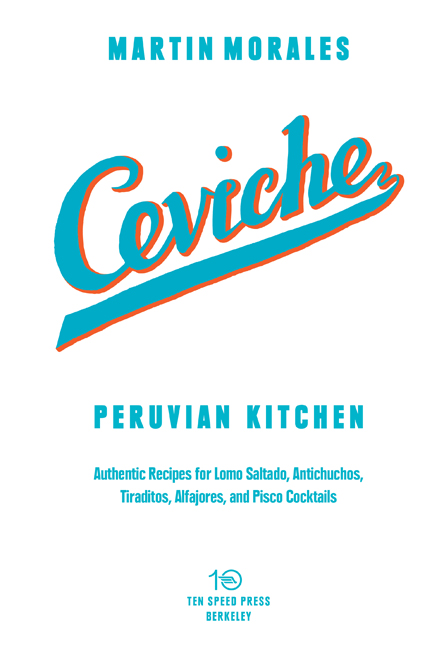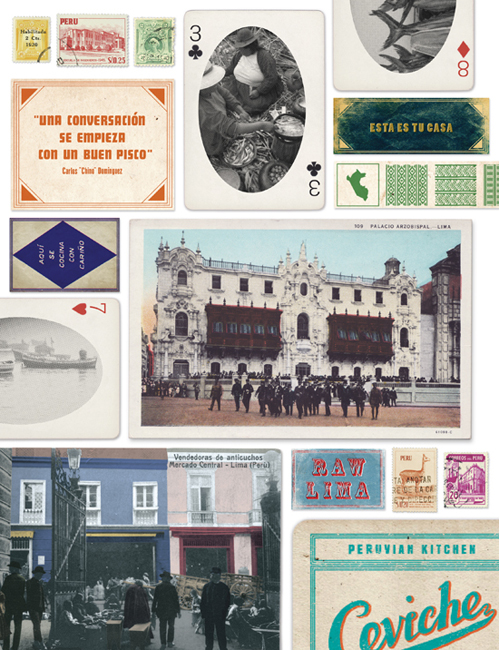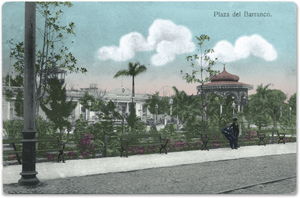Dedicated to all the children in Peru who are supported by the charity www.amantani.org.uk
Copyright 2013 by Martin Morales
Photographs copyright 2013 by Paul Winch-Furness
All rights reserved.
Published in the United States by Ten Speed Press, an imprint of the Crown Publishing Group, a division of Random House LLC, a Penguin Random House Company, New York.
www.crownpublishing.com
www.tenspeed.com
Ten Speed Press and the Ten Speed Press colophon are registered trademarks of Random House LLC
Originally published in the United Kingdom as Ceviche by Weidenfeld & Nicolson, The Orion Publishing Group, Ltd., in 2013
Photographs by Paul Winch-Furness with the exception of the following photographs reprinted with permission:
Santiago Barco Luna
Leslie Searles
, Maria Fe Romero
Solange Adum
Library of Congress Cataloging-in-Publication Data
Morales, Martin, 1973- author.
Ceviche Peruvian kitchen authentic recipes for lomo saltado, anticuchos, tiraditos, alfajores, and pisco cocktails / Martin Morales. First American edition.
pages cm
Summary: The first major Peruvian cookbook published for a US audience, featuring 100 recipes from the owner of Londons critically acclaimed restaurant Ceviche-- Provided by publisher.
ISBN 978-1-60774-641-6 (hardback) ISBN 978-1-60774-642-3 (eBook) 1. Cooking, Peruvian. 2. Ceviche. I. Title.
TX716.P4M66 2013
641.5985dc23
2013048754
Hardcover ISBN: 978-1-60774-641-6
eBook ISBN: 978-1-60774-642-3
Food styling by Annie Nichols
Props styling by Polly Webb-Wilson
UK edition edited by Abi Waters
VISIT CEVICHE AT WWW.CEVICHEUK.COM
v3.1
Notes on the recipes
Spoon measures are level and 1 tablespoon = 15 ml, 1 teaspoon = 5 ml.
Preheat ovens before use and cook on the center rack unless specified otherwise. If using a convection oven, reduce the heat by 20F to 40F / 10C to 20C.
Large free-range eggs have been used unless otherwise stated.
All herbs are fresh unless otherwise stated.
This book contains recipes made with raw eggs. Those with known allergic reactions to eggs and egg derivatives, pregnant or breast-feeding women, very young children, the elderly, and anyone with a compromised immune system should avoid recipes containing raw egg.
CONTENTS
INTRODUCTION
There is a Peruvian saying my great-aunt Carmela taught me: aqu se cocina con cario, which translated means here we cook with loving care. This is the motto at our restaurant Cevicheits what Peruvian food is all about. The other side of what we do is sazn : the quest to achieve a perfect balance of flavors. I have spent a lifetime working on this. Like most Peruvians, I am obsessed with cooking and I love sharing our amazing food.
GROWING UP WITH THE FOOD OF PERU
I was born in Lima and spent the first eleven years of my life in Peru. My mother came from a remote village in the Andes and my father from Leicester in the middle of England. In many ways these years of my life were wonderful, not least because they set me on the road to developing my two main passions: music and food.
I was raised in a family that always made sure there was plenty of good food to eat. They made it their business to teach me everything they knew about foodmy great-aunts Carmela and Otilia in particular ( pictured below ). They would take me to the market with them, where I would watch animals destined for the pot running among tables piled high with rice, corn, potatoes, and a dizzying array of different fruits, vegetables, and herbs. I loved helping my great-aunts in the kitchen; cleaning rice, peeling potatoes and mangoes, podding fava beansI learned how to make dishes that I still cook for my children today.
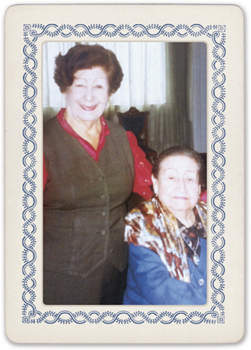
I spent as much time as I could on Makaha Beach in Lima, learning to surf and trying to tame the waves. I loved the Pacific Ocean and relished eating all the delicious fish and seafood that came from it. My father would take us to stalls in the nearby district of Chorrillos for ceviche. Sitting on the beach with the sun pounding down on me and my mouth alive with the lime and chile kick of ceviche was as exhilarating as riding the tallest wave. There is no doubting why ceviche has become Perus national dish. It is found everywhereat restaurants, street carts, beach hutsand everyone has his or her own way of making it. My father also took us on fishing trips that always ended with a barbecue on the beach. Now I appreciate what a luxury it was to be able to eat fish that I had literally just pulled from the sea.
REMOTE LIVING
We would occasionally make the arduous journey back to my grandparents home in the mountains. They lived in a remote Andean village called Cachicadn, well known for its healing thermal waters. At least once every few months my grandmother Mamita Naty would send her sisters in Lima a hamper of food full of fresh and dried potatoes, home-cured hams, cereals, chancaca honey, beautiful white-green eggs with the deepest of yellow yolks, rosquitas (ring-shaped savory pastries), tamales, and sometimes live poultry reared by her and my grandfathera turkey for Christmas, and a hen or cockerel at other times. Everything was homegrown or reared and then cooked by my aunties.
Getting to the village was a long and tortuous business. It involved an eighteen-hour bus ride, winding along treacherous cliff-facing dirt roads, but it was always worth the trip, not least because we were treated to some truly delicious Andean specialties. These included numerous varieties of potatoes I had never tried before and havent seen since, sweet prickly pears, hearty stews, and soups much beloved by the locals, such as shambar , made from pork, grains, and beans. They also included some wonderful meat dishes, made with my grandparents own reared, free-range animals, including the guinea pigs that lived happily under the stove in their kitchen, which were delicious either roasted or cooked with chiles and spices.
Thanks to my mothers family, and my fathers willingness to let me try all the different kinds of street foods on offer in Lima, I was able to experience every type of food: the Andean dishes still much loved by indigenous people, the street foods made popular by the Afro-Peruvians and Criollos, and the wok-cooked dishes available in the many chifas (Chinese Peruvian restaurants) throughout Lima and emulated by my aunties. There were the European-influenced dishes that had become truly Peruvian, and finally, of course, the ceviches in all their variations, including those influenced by the Japanese. I loved it all. Buying, cooking, and eating food was such an important part of my childhood. Those chefs, street sellers, fishermen, relatives, and restaurants all play key roles in my memoriesthey greatly affected my happiness and who I am now. Little did I know that their everlasting influence would send me on a mission to put Peruvian food on the map in Britain.




